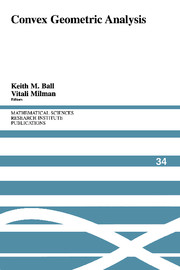Book contents
- Frontmatter
- Contents
- Introduction: The Convex Geometry and Geometric Analysis Program MSRI, Spring 1996
- Msri Program Seminars
- Integrals of Smooth and Analytic Functions over Minkowski's Sums of Convex Sets
- Localization Technique on the Sphere and the Gromov-Milman Theorem on the Concentration Phenomenon on Uniformly Convex Sphere
- Geometric Inequalities in Option Pricing
- Random Points in Isotropic Convex Sets
- Threshold Intervals under Group Symmetries
- On a Generalization of the Busemann-Petty Problem
- Isotropic Constants of Schatten Class Spaces
- On the Stability of the Volume Radius
- Polytope Approximations of the Unit Ball of ℓnp
- A Remark about the Scalar-Plus-Compact Problem
- Another Low-Technology Estimate in Convex Geometry
- On the Equivalence Between Geometric and Arithmetic Means for Log-Concave Measures
- On the Constant in the Reverse Brunn-Minkowski Inequality for p-Convex Balls
- The Extension of the Finite-Dimensional Version of Krivine's Theorem to Quasi-Normed Spaces
- A Note on Gowers' Dichotomy Theorem
- An "Isomorphic" Version of Dvoretzky's Theorem, II
- Asymptotic Versions of Operators and Operator Ideals
- Metric Entropy of the Grassmann Manifold
- Curvature of Nonlocal Markov Generators
- An Extremal Property of the Regular Simplex
- Floating Body, Illumination Body, and Polytopal Approximation
- A Note on the M*-Limiting Convolution Body
Asymptotic Versions of Operators and Operator Ideals
Published online by Cambridge University Press: 27 June 2025
- Frontmatter
- Contents
- Introduction: The Convex Geometry and Geometric Analysis Program MSRI, Spring 1996
- Msri Program Seminars
- Integrals of Smooth and Analytic Functions over Minkowski's Sums of Convex Sets
- Localization Technique on the Sphere and the Gromov-Milman Theorem on the Concentration Phenomenon on Uniformly Convex Sphere
- Geometric Inequalities in Option Pricing
- Random Points in Isotropic Convex Sets
- Threshold Intervals under Group Symmetries
- On a Generalization of the Busemann-Petty Problem
- Isotropic Constants of Schatten Class Spaces
- On the Stability of the Volume Radius
- Polytope Approximations of the Unit Ball of ℓnp
- A Remark about the Scalar-Plus-Compact Problem
- Another Low-Technology Estimate in Convex Geometry
- On the Equivalence Between Geometric and Arithmetic Means for Log-Concave Measures
- On the Constant in the Reverse Brunn-Minkowski Inequality for p-Convex Balls
- The Extension of the Finite-Dimensional Version of Krivine's Theorem to Quasi-Normed Spaces
- A Note on Gowers' Dichotomy Theorem
- An "Isomorphic" Version of Dvoretzky's Theorem, II
- Asymptotic Versions of Operators and Operator Ideals
- Metric Entropy of the Grassmann Manifold
- Curvature of Nonlocal Markov Generators
- An Extremal Property of the Regular Simplex
- Floating Body, Illumination Body, and Polytopal Approximation
- A Note on the M*-Limiting Convolution Body
Summary
The goal of this note is to introduce new classes of operator ideals, and, moreover, a new way of constructing such classes through an application to operators of the asymptotic structure recently introduced by Maurey, Milman, and Tomczak-Jaegermann in Op. Th. Adv. Appl. 77 (1995), 149-175.
1. Preliminaries
1.1. Notation. We follow standard Banach-space theory notation, as outlined in [LTz]. Throughout this note X will be an infinite dimensional Banach-space with a shrinking basis
The notation [X]n will stand for the head subspace (span and for the tail subspace (the closure of span Pn and P>n are the coordinate-orthogonal projections on these subspaces respectively.
A vector is called a block if it has finite support, that is, if it is a finite linear combination of elements of the basis. The blocks v and ware said to be consecutive (υ < w) if the support of υ (the set of elements of the basis that form υ as a linear combination) ends before the support of w begins. is the collection of all n-tuples of consecutive normalised blocks; thus means normalised finite support vectors.
1.2. An intuitive introduction to asymptotic structure. The language of asymptotic structure has been introduced to study the essentially infinite dimensional structure of Banach-spaces, and to help bridge between finite dimensional and infinite dimensional theories. This approach does generalise spreading models, but takes an essentially different view. Formally introduced in [MMiT], it has already been studied, extended and applied in [KOS], [OTW], [T], [W1] and [W2]; it is closely related to the new surge of results in infinite dimensional Banach-space theory, and especially to [G] and [MiT].
Information
- Type
- Chapter
- Information
- Convex Geometric Analysis , pp. 165 - 180Publisher: Cambridge University PressPrint publication year: 1999
